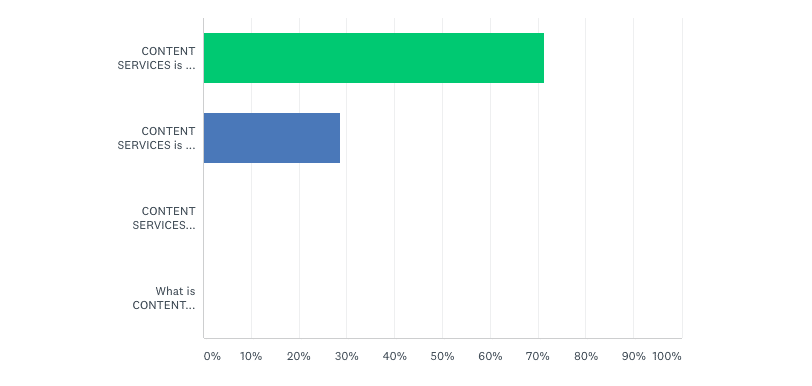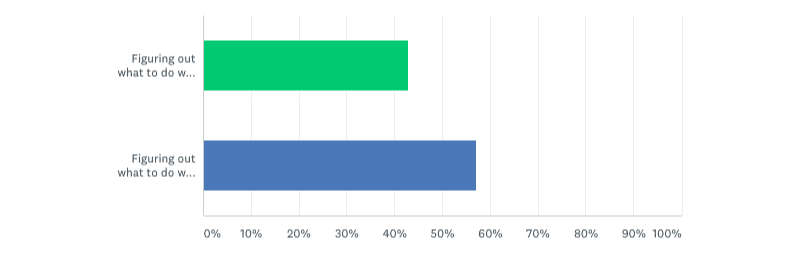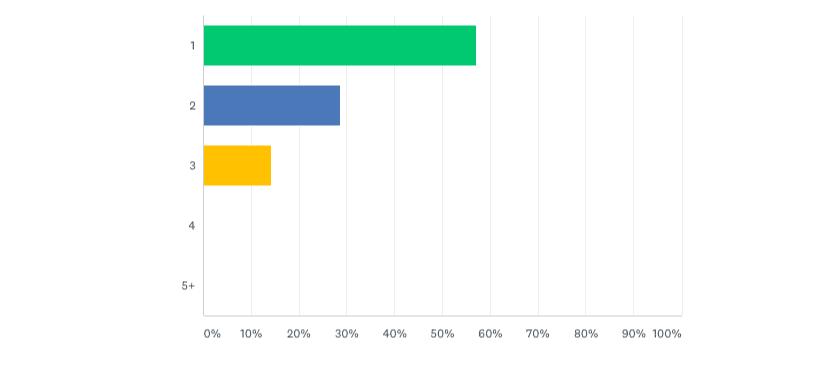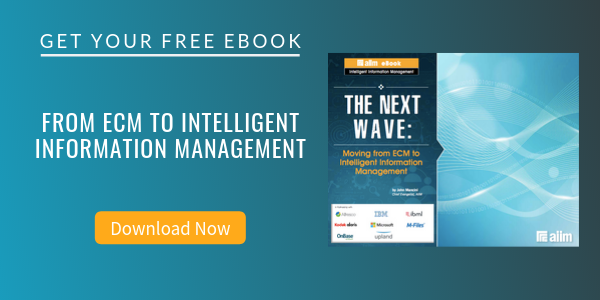![The State of Content Management in 2020 [Expert Tips & Research]](https://info.aiim.org/hubfs/AIIM_Blog/Content%20Management%20%E2%80%93%204%20Tips%20from%20the%20Experts%202.jpg)
The State of Content Management in 2020 [Expert Tips & Research]
Enterprise Content Management (ECM)
Few announcements in information management have been bigger than Gartner’s article heard round the world that announced the death of Enterprise Content Management (ECM) as we knew it.
Michael Woodbridge’s quote gets straight to the point here:
“ECM is now dead (kaput, finite, an ex-market name), at least in how Gartner defines the market. It’s been replaced by the term content services, a strategic concept that covers three aspects, namely content services Applications, Platforms and Components.”
Since this article was published in 2017, the Information Management industry exploded with new questions, like, Is ECM really dead? What’s this content services thing?
It turns out, the story is just a little more complicated than one technology being replaced by another.What does content management look like in 2020, years after ECM died?
AIIM has been the go-to resource for information professionals to find research, education, and training for over 70 years. Throughout those years we've seen technologies come and go, new trends emerge, and the industry shift in different directions. To help you understand the current state of content management, we polled a group of experts to help us get the full story, including:
- A Current Snapshot of Content Management
- Start with CONTENT? Start with PROCESS? –Is there a RIGHT Approach?
- Content and Unstructured Information - The Known Evil vs. The Unknown Evil
- 4 Content Management Tips from the Experts
A Current Snapshot of Content Management
How many content management systems do you currently have in your organization?
The majority of the respondents are working with one content management system (57%). While twenty-nine percent are currently using two systems, and 14% employ three.
There's been a lot of conversation about CONTENT SERVICES in the past few years. Which statement best describes the situation in your organization?

Here's how people describe their organizations:
- CONTENT SERVICES is a key concept when we think about managing information. (71%)
- CONTENT SERVICES is a useful goal, but managing information here is still really all about ECM. (28%)
- CONTENT SERVICES doesn’t really mean much here. (0.%)
- What is CONTENT SERVICES? (0%)
The initial idea behind ECM was to get all of an organization’s information managed in one central repository. One system to manage it all. Or, for my fellow Lord of the Rings fans, we could describe it as – One system to rule them all, one system to find them, one system to bring them all and in the darkness bind them!
But for years AIIM has defined ECM as:
“Neither a single technology nor a methodology nor a process, it is a dynamic combination of strategies, methods, and tools used to capture, manage, store, preserve, and deliver information supporting key organizational processes through its entire lifecycle.”
Notice this definition includes all of the supporting strategies, methods, and tools in addition to the technology itself. Whether it’s ECM, content services, or anything else that may come in the future, information management is an intersection of methodology and technology.
As we enter into an era where technology is changing from ECM to content services, so too do the strategy and methods involved. This transition has birthed the term "Intelligent Information Management (IIM)." IIM incorporates and leverages the modular approach of content services to get the work done in the organization.
In other words, the role we expect content and information management to play in our organizations is more than ECM (especially in its more traditional transaction-centric and records-centric definition). The issues and strategies that organizations will face with content management are further morphed by the coming tidal wave of big data and analytics.
This is why 100% of people polled prioritized content services in their organization in some way.
Start with CONTENT? Start with PROCESS? –Is there a RIGHT Approach?
Which statement best describes your organization?

We asked the experts to pick which statement best describes their organization:
- We start with CONTENT, then we think about how to integrate PROCESS. (57%)
- We start with PROCESS, then we think about how to integrate CONTENT. (43%)
With a close to an even split, it begs the question – Is there a right approach?
This tends to be a bit of a chicken and the egg scenario. Content fuels the process, but at the same time, the process drives the content. Which is the best approach? Unfortunately, it depends…. If you’re identifying new streams of information coming into your organization, you’re likely starting with the content. You’ll want to consider the formats used, the frequency, and ultimately where this information needs to go.
If you’re starting with the process, you’ll want to first identify what the process will be designed to do and work from there. You’ll want to locate the content you need and use the same type of considerations for your content like format, frequency, and destination.
Content and Unstructured Information - The Known Evil vs. The Unknown Evil
Which is a bigger priority for your organization?

We asked which was a bigger priority:
- Figuring out what to do with all of the content and unstructured information we already have. (43%)
- Figuring out what to do with the new content and unstructured information coming into our organization. (57%)
Again, our experts were almost evenly split. So again, we asked – is there a better approach?
There’s a concept in AIIM’s Training called ‘benign neglect.’ The basic idea is an organization will decide to hold off on dealing with legacy paper documents until someone asks for it or the need arises.
Another school of thought is to ignore all incoming information and focus on digitizing the paper-based legacy content.
So, which of these is the better approach?
The long and short of it is you really have to do both. If you get sued, the court doesn’t care if it’s old stuff or new stuff, they just care that you have it and you’re able to find it.
AIIM recommends focusing on your current business needs and prioritizing. If the current business needs support digitizing the legacy content, focus on that first. If there are greater business needs served by focusing on the incoming content, focus on that first.
Think about it this way. Let’s say you’re on a work call when another call comes in on call-waiting. What do you do?
For most, the answer starts with determining who is calling. The reason we do this is to rank the priority of the two calls. If you peek at the caller ID and see it’s your buddy calling you up to go fishing this weekend, your priority would be to stay on the work call. But if it were a call about an important family matter, you would likely need to answer it and put the work call on hold.
Use this type of thinking to help you prioritize in your organization and determine which is the bigger priority – the new content and unstructured information, or your legacy content and unstructured information.

4 Content Management Tips from the Experts
It’s a lot. There’s so much to think about with content management and your digital transformation journey that it can easily become overwhelming. At AIIM, we're all about helping information professionals find value - and opportunity - in the information and data within your business.
With this in mind, we asked the experts, what’s ONE WAY that you could improve the effectiveness of your content management system(s)?
Here's what they said:
1. Your Information Needs a Home
Alaris' Petra Beck notes, “Tame information chaos by intelligently capturing business inputs as part of an Intelligent Information Management system in order to make them valuable for the business. The biggest roadblocks to efficiency are business inputs and content repositories that remain in silos (or in paper) and require a manual effort to process as part of a business transaction.”
ecmXperts' Michael Corts recommends adding "cloud-based access to server share content."
Informsys Consult’s Carlos Bassi adds, “Make the content management system the only source of information.”
The key is to have a place for your stuff. Whether you operate with one content management system, or multiple systems, the challenges may be different but you’ll want to have one source of information. Work to break down any information silos, and move away from paper and manually-driven processes.
2. Change Management + Usability = Adoption
Most people aren’t information managers, they are just using information to get their jobs done. Therefore, usability becomes a big factor in the adoption equation.
To quote Einstein, “Everything should be made as simple as possible, but no simpler.”
Raoul Miller from Team IM adds, “Usability - that's the key to any system. Needs to be simple and fully integrated with multiple devices and applications.”
When it comes to usability, it’s often best to skip all the bells and whistles as noted here by David Yoon of Shinydocs:
“We've been attending ECM conferences for years and have seen countless keynote presentations breathlessly showcasing intuitive UI updates, advanced process workflows, personalized business intelligence dashboards, AI fueled context aggregators. These are just pretty bandages for a gaping wound.”
Instead, he recommends focusing on adoption.
“Adoption throughout the enterprise, across departments, for the lifecycle of critical documents. It needs to be more than just a place where documents go to die once a project is completed. You can talk about top down directives, cross departmental buy-in, grass roots advocacy - but as soon as the ECM gets in the way of getting work done, people find technological workarounds. Most folks at your organization are not records managers - they just want to get stuff done.”
To echo David, users just want to be able to get stuff done. That means being able to save stuff, find stuff, and use stuff. But, the systems in place to help with this need to be transparent and not something that gets in the way of them doing their jobs without a complex system.
3. Put the User Needs First
AIIM believes that Information Management and Information Governance should NOT be done just for the sake of doing them. These practices should be done in order to support the business to do its business.
Ed Steenhoek of the Informed Group recommends, “Fulfill enterprise wants (including governance, records) as a result of user needs (including running the business) rather that forcing user wants into an - all too often - straitjacket of enterprise needs.”
4. Align Information Architecture to Business Functions and Roles.
Lorne Rogers of Aria Consulting suggests that, “Organizations need to able to radically increase the alignment of Information Architecture to business functions and align personalized outcomes directly to organizationally defined roles.”
To build on this, ask who your audience is. When you create taxonomies and metadata models, you should focus on how the people who will be working with the information think. It has to have the perspective of the people that are working with it. Think about the people who are doing the work, how can we make their work more efficient?
Small Steps, Big Impact
Content services are an important component to intelligent information management - but they aren't the only one. Intelligent information management needs process services and analytics services too, but this only tells the technology side of the story. In the people, process, technology framework, technology is the least important to the success of an IIM initiative. Organizations should focus at least as much time, effort, and resources on ensuring that processes are clear and correct and that staff understand, support, and are trained on them.
My recommendation comes from a personal mantra of mine – 1% better every day. I practice this approach in life to help calm the overwhelming list of self-improvements I have in my head to eat better, exercise more, read more, learn new skills, and so on.
There’s only so much time in the week and it would be impossible to accomplish everything I feel I need to. So, instead, I take the 1% approach and just try to do (at least) one thing to improve each day. Taking small bites like this helps clear my mind of the nagging list by recognizing that even small steps, are still steps toward the overall goal.




